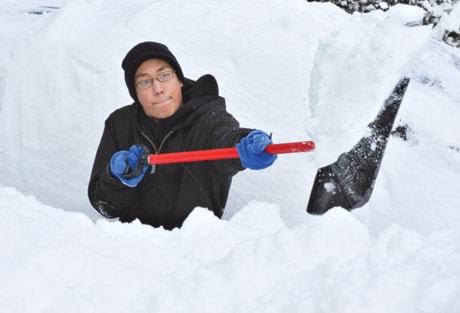When it comes to snow, human nature seems to be either to play in it or move it out of the way. Snow play has plenty of hazards, from slush balls to the perils of downhill slopes — winter sports are estimated to injure about a half million of us each year.
But that nasty chore of shoveling, scraping or blowing sow and ice is nearly as dangerous to our health and more onerous because it’s almost always an involuntary activity.
A study published in mid-January in the American Journal of Emergency Medicine concluded that there were an average of 11,500 snow-shoveling injuries and related medical emergencies each year from 1990 through 2006.
The toll is even larger when all types of “manual snow and ice removal tools” are lumped together, as they have been recently in the same national network of hospital emergency departments reporting injuries to the U.S. Consumer Product Safety Commission. The most recent estimates from 2009 suggest there were more 26,000 injuries from shovels, ice breakers, scrapers and similar implements.
There’s little doubt that snow shoveling can kill. Published studies based on death certificates and weather records in Massachusetts and Michigan have showed that heart disease deaths generally and deaths from exertion-related cardiac arrest specifically rise by 22 per cent or more in the weeks during and after a heavy snow.
The Emergency Medicine study, done by the Center for Injury Research and Policy at Nationwide Children’s Hospital in Columbus, Ohio, found that while heart injuries accounted for only seven percent of all snow-shovel-related injuries, they were by far the most serious. They were responsible for half of all hospitalizations and all of 1,647 fatalities associated with shoveling snow.
Dr. Gary Smith, center director and senior author of the study, said, “Not only is the heart’s workload increased due to shoveling snow, but cold temperatures also add to the chances of a heart attack in at-risk individuals.”
Smith and other medical experts say anyone with a history of heart disease, high blood pressure or high cholesterol levels or who smokes or leads a sedentary lifestyle should skip snow shoveling.
Either hire someone else to do it or use less strenuous tools like salt or snow blowers.
Snow blowers carry their own risks, however. The CPSC injury network calculates that about 6,000 of us were injured using the machines in 2009, including at least one reported heart attack. Injury reports show most of the damage comes either from falls or strains moving the machines or trauma to fingers and hands reaching inside snow-blowing chutes and injured by the blades that move the snow.
While the cardiac risk and back strain of manual snow removal falls mostly on men older than 55, the Nationwide Children’s study found that youths under age 19 make up a substantial minority of snow-shovel casualties — an average of 1,750 a year.
Smith said the patients in this age group were almost 15 times more likely than those in any other bracket to be hit by a snow shovel. About two-thirds of those injuries were to the head, suggesting that kids need to be reminded not to use the shovels as toys -- or weapons -- and to keep a safe distance from other shovelers.
But case reports from childhood injuries recorded in 2009 show that even youngsters can experience back and chest pains serious enough to go to an emergency room if they overdo it with a snow shovel.
Those reports also show that even when snow tools are classified as the culprit, they may not be entirely at fault. One case describes a 7-year-old boy who was jumping on a trampoline when he fell and hit his forehead on a snow shovel handle. An 8-year-old boy fell off a porch and broke his arm on a shovel handle in an incident reported in late May.
In another report, a 7-year-old girl was hit in the stomach by a windshield ice scraper that went airborne when the car she was riding in was rear-ended, resulting in a minor abrasion.
